|

SAM FERRIS "MARATHON
MAN"
BY TREVOR MARTIN
Most of us this summer enjoyed the spectacle of the
greatest of the worlds athletes gathered in Barcelona to
compete for Olympic gold. The marathon, held over 26 miles
represents for many the pinnacle of endurance, tactics and
true grit. The games of 1924 were held in Paris and anyone
who watched the film "Chariots of Fire" would have been
given a good impression of the period, styles and equipment
of the runners.
There were many famous names at these games Paarvo Nurmi
winner of nine gold medals, Eric Liddell who refused to race
in the 200 metre final because it was held on a Sunday,
Johnny Weissmuller winner of five swimming golds and later
to become the screen Tarzan. Amongst all these world famous
characters was a man from the town of Dromore, Sam Ferris,
one of the greatest distance runners that Northern Ireland
and the United Kingdom was ever to produce, made his Olympic
debut.
Sam Ferris was born in the townland of Magherabeg near
Dromore in August 1900 which coincidently was the year of
the second Olympic Games, also held in Paris. Sam's mother Minnie
Clarke was said to be a bit of an athlete and it was not
unknown to see her running through the fields hurdling the
stooks of corn. Sam lived for the early period of his life
at Magherabeg, however he moved to Glasgow with his father
when his mother tragically died. They only stayed in Glasgow
for a few years, returning to Dromore to the rest of the
family. Sam was like his mother, always interested in
running and at the early age of seventeen he joined
Shelteston Harriers, winning many prizes in the Junior Open
Category.
Olympic Games, also held in Paris. Sam's mother Minnie
Clarke was said to be a bit of an athlete and it was not
unknown to see her running through the fields hurdling the
stooks of corn. Sam lived for the early period of his life
at Magherabeg, however he moved to Glasgow with his father
when his mother tragically died. They only stayed in Glasgow
for a few years, returning to Dromore to the rest of the
family. Sam was like his mother, always interested in
running and at the early age of seventeen he joined
Shelteston Harriers, winning many prizes in the Junior Open
Category.
Sam was also used by the local pigeon men to run in the
rings of the first birds home as there was only one pigeon
clock in the Town, thus giving them an extra time advantage
over their colleagues.
When Sam was eighteen the First World War had been raging
for four years, so like most young men of his age he decided
to join up. He joined the fledgling Royal Air Force, then
known as the Royal Flying Corps and on enlistment he was
posted to India. During that posting, however, he did little
or no running, preferring to devote his energy to other
sports such as football. After his service was up he
returned to Dromore, once again taking up his first love of
running. He didn't have to wait long for success winning
many local races including the Co. Down One Mile
Championship.
In December 1923 he rejoined the Royal Air Force and was
stationed in Uxbridge where he competed in a cross country
race. Although he only came third his talents came to the
notice of Bill Thomas of Herne Hill Harriers who persuaded
him that his true forte might be long distance rather than
cross country running. Bill Thomas's entreaty had an effect
on Sam and he joined Herne Hill Harriers with whom he stayed
throughout his career. Many young men who had fought in the
war were taking to serious athletics, Bobby Mills who had
been awarded a Distinguished Flying Cross in the Royal
Flying Corps won the 1920 Polytechnic marathon, although
prior to the race had never run further than 14 miles. Sam's
first 20 mile race was not a success so it was important for
him to build up the stamina necessary for long distances.
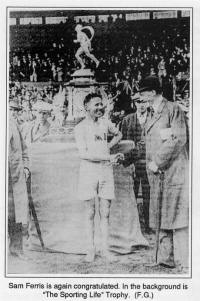 In
the 1924 Olympic trials there were 80 starters one of whom
was Sam Ferris competing in the first ever marathon race of
his career. Despite conditions being poor and a lack of
experienced runners in the field, by the 23 mile point 3
runners were well in the lead. Ahead of Sam in first and
second place were Duncan Wright and Jack McKenna. McKenna
was in all sorts of trouble and collapsed with exhaustion
just past the 25 mile point. Ferris, although exceptionally
strong, could not catch the Scotsman Wright who finished in
2.53.47, only 45 seconds in front. It would appear therefore
that Bill Thomas was right and Sam's talents lay in the
longer distances. It was as a result of this achievement
that he was picked for the British Olympic team to compete
in Paris in 1924. In
the 1924 Olympic trials there were 80 starters one of whom
was Sam Ferris competing in the first ever marathon race of
his career. Despite conditions being poor and a lack of
experienced runners in the field, by the 23 mile point 3
runners were well in the lead. Ahead of Sam in first and
second place were Duncan Wright and Jack McKenna. McKenna
was in all sorts of trouble and collapsed with exhaustion
just past the 25 mile point. Ferris, although exceptionally
strong, could not catch the Scotsman Wright who finished in
2.53.47, only 45 seconds in front. It would appear therefore
that Bill Thomas was right and Sam's talents lay in the
longer distances. It was as a result of this achievement
that he was picked for the British Olympic team to compete
in Paris in 1924.
The marathon team for the Olympics was Jack McKenna,
Duncan Wright and Sam Ferris and of the three runners who
finished in the best position. The heat combined with the
route chosen for the course, much of it over cobbled roads,
led many including Wright to drop out; the only time that
Wright was ever to fail to complete a marathon. Sam's fifth
place in 2.52.26, behind the eventual winner Alban Stenroos
of Finland was the best achievement to date for a British
runner in an Olympic marathon. The achievement is even
better when we see that at the 23km mark Sam was 30th and
even after 35km was only 9th. The omens looked good, what
might he achieve in future years as it is generally thought
in the world of running that marathon runners reach their
peak much later than those at the shorter distances?

Sadly for Sam he was to be bitterly denied Olympic gold
for although he competed in two further Olympics, (Amsterdam
in 1928 and Los Angeles in 1932) the gold was tragically to
elude him. It was the 1932 games in Los Angeles that was
perhaps to prove to be his greatest disappointment for
through a combination of fate and bad management he lost the
gold medal. In later years he was to relate this story, one
that best illustrated the lack of a co-ordinated and
professional approach on behalf of the administrators of the
British Olympic team in those early days. When Sam and
Duncan Wright arrived they were given no briefing on the
course, indeed Sam only saw the course once before the
actual race. In contrast Juan Zabala of Argentina, the
eventual winner had trained on the course and knew it
intimately. On race day they were given their British
running vests to find that they were much too long and they
both felt that it would be a disaster to use them in the
competition. Duncan Wright was adamant he would not use the
vest and he eventually competed wearing his own Scotland
vest. Sam tried to redesign his vest cutting some eighteen
inches off it's length, but this was to prove catastrophic
during the race. After a distance into the race the vest
began to ride up Sam's back exposing the kidney area to the
wind and causing it to chill. He stopped several times
during the race to adjust the vest eventually, holding it
down using the safety pins that held up his number. Despite
this he ran well coming up through the field until he had
Juan Zabala in his sights. Once again Sam's backup team were
to let him down. He was told Zabala was going well and to
ease off for the silver medal. The truth was that Zabala had
been through a difficult period in the race and was on his
last legs. A concerted attack by Sam at this point would
possibly have
finished him off. Sam finished 2.31.55, only nineteen
seconds behind Zabala and won the Olympic silver medal, with
both runners breaking the world record.
Sam eventually got over his disappointment and raced on
for many years, increasing his tally of awards and honours
both national an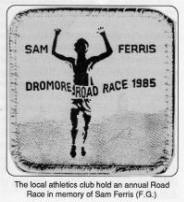 d
international. He won the first ever AAA title to be
contested, was victorious in eight consecutive Polytechnic
marathons and was runner up in the first Empire Games in
1930. d
international. He won the first ever AAA title to be
contested, was victorious in eight consecutive Polytechnic
marathons and was runner up in the first Empire Games in
1930.
He set a course record in Turin of 2.46.18 beating the
Belgian, French and Italian champions. They even came to
England to get their revenge but, he destroyed them winning
in 2.40.32 a margin of five minutes. Course records were his
speciality, in Liverpool he came home in 2.33.00 some
fifteen minutes in front of the next man.
Sam, a strict non smoker held strong views on marathon
running and indeed training in general. A newspaper article
written in 1931 said of him
"In order that the novice may evaluate Sam Ferris, he
must do as Sam Ferris did, train wisely, train
conscientiously and train
consistently. Spasmodic bursts of energy serve no useful
purpose."
His training for any marathon began some eight weeks
before the race and was set to a strict regime, one that he
kept to and which served him well.
As a Warrant Officer in the Royal Air Force Sam served in
many stations throughout the world over the years, at Dieppe
in 1940 he was the officer in charge of evacuating the men
prior to the advancing German Army.
Henry Fairley a local man and relative of Sam remembers
spending time with him, his wife and daughters in India in
1938. Sadly Sam died in the late seventies but his widow
Marjorie is still alive and living peacefully in a cottage
in Rosson-Wye, England. I'm sure that many who read this
story will like me be proud that a man from Dromore has
written his name into Olympic history.
I would like in my article to acknowledge the help of
Seamus McKeown and Henry Fairley for the invaluable
information that they supplied in compiling this incredible
story of surely one of Dromore's greatest sons.

TALE OF A
TOWNLAND
BY MARTIN CAMPBELL
Extracts from a thesis written by Martin Campbell,
Belfast in the Spring of 1992. The Townland of Islandderry
lies 3 miles to the west of the town of Dromore.
One of the first signs of settlement in the area is the
"crannog" in Islandderry lake - a man made island supported
on oak beams and reached by a causeway. It was used as a
place of safety by both man and beast. In the early 19th
century a dug-out canoe and oars were found nearby. The lake
itself was man made in prehistoric times and in the 17th
century stretched to over 20 acres. Today, with constant
drainage schemes it has been reduced to approximately 2
acres. Flowing across the north of Islandderry and dividing
it from the neighbouring townland of Gregorlough is the
Shankerburn, the
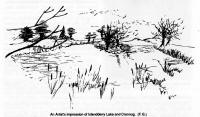 main
stream in the area, it flows into the lake. main
stream in the area, it flows into the lake.
Prior to the rebellion of the Irish Catholics of October
1641 the townland was the property of Art Oge Mac Glaisne
Magennis. Following the defeat at the hands of Cromwell in
February 1642 Art Oge had to forfeit his lands to the Crown.
The first proprietor was Alexander Woodall/Waddell from
Moffat Hills in Lanarkshire, Scotland, who paid a quit rent
of �5.13.4 to Art Oge for 679 acres, 3 roods and 4 perches.
This was the beginning of a long association between the
Waddell family and Islandderry.
Alexander Waddell built Islandderry house on the site of
a rath overlooking the surrounding countryside, across the
Lagan, as far as the
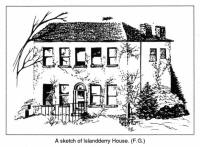 Mournes. Mournes.
A two storey building, it was built in a style similar to
the peel houses of lowland Scotland. Interesting features of
the house are a well in the basement and a reputed escape
tunnel running from the house and coming up on the other
side of the Lagan about a mile distant.
Alexander Waddal married Elizabeth Hamilton and over the
next hundred years or so his progeny quietly prospered in
the area. Thus the Islandderry estate came down through the
Waddell family into the possession of Robert (b. 1752
d.1810). This description of him was given to Lord Downshire
by Thomas Lane of Hillsborough with whom he, Robert, had had
a serious difference of opinion "as garrulous as an ignorant
and uninformed man may be". Robert's son James (b.1782
d.1859) fought under Wellington's command in the Peninsular
War retiring with the rank of Major to Islandderry. He was
responsible for the closing of the old county road and the
building of the road round the lake - now the Lough Road -
for which he was paid one shilling by the County.
Catherine Meade Waddell (b.1790 d.1869) also lived in
Islandderry House at this time. A spinster lady, she
undertook the building of the first, and only school house
in the townland. Built 200 yards from the site of a former
hedge school, it consisted of one large classroom and a
further two living rooms for the teacher - a Mistress Mary
Milligan.
In the second Report of the Commissioners of Irish
Education Inquiry of 1826 one, James Murphy is listed as the
Headmaster at an annual salary of �19.0.0.

It was a fee paying school of the Church Education
Society and by 1858 had 56 children male and female, 22 of
whom belonged to the Established Church and 34 were
Presbyterian. The school cost �53 to erect.
Thirty pounds being donated by the Waddell family and
twenty three pounds by the Church Education Society of
Kildare Place, Dublin.
Since 1938 the building has been home to the Kilntown
Orange Lodge.
On the 31st of October 1796 the Islandderry Yeomanry was
formed with Robert Waddell as Captain. When they were
disbanded in 1803, by which time James Waddell was
Commandant, he was given two inscribed Irish silver
two-handed cups "As a token of their respect, gratitude and
esteem" One still exists in New Zealand - the other was
stolen. Others named in the Yeomanry records are Wm. Boys,
Jn. Magill, Joseph Hanna, Jn. Harrison and Lieut. Wm.
Nicolson.
Although, at the time of the Art Oge land forfeiture the
population of the townland was only 18 (16 Scots and English
and 2 Irish), with the coming of the outside landlords there
was an influx of people to farm the land. Many small farms
were rented out by the Waddells, the main one being
Islandderry Farm about 1.5 miles north east of Islandderry
House on the road to Hillsborough. Originally comprising 295
acres it had grown by absorption of the surrounding land,
until, in the mid 19th century it stood at 426 acres. Today
it is 457 acres.
The Griffith Valuation of 1863 shows the townland
supporting 19 small farms ranging from Mary Jane Waddell 117
acres to Samuel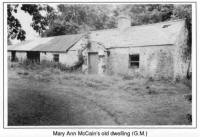 Gooley with only 2 acres. Other names listed as being tenant
farmers are Poots, McMurray, Preston, Savage, Patterson,
Colter, Isabella McAvoy, Beggs and Downey. Many of these
names are now periferal to the townland. As the land was
fertile, with little or no bog, the main crops grown were
barley, potatoes, turnips and corn. Any spare was usually
taken into Dromore market.
Gooley with only 2 acres. Other names listed as being tenant
farmers are Poots, McMurray, Preston, Savage, Patterson,
Colter, Isabella McAvoy, Beggs and Downey. Many of these
names are now periferal to the townland. As the land was
fertile, with little or no bog, the main crops grown were
barley, potatoes, turnips and corn. Any spare was usually
taken into Dromore market.
Behind the old McCain house, there is a disused quarry.
The rock, known locally, as pigeon rock, is a baked and
hardened limestone - a poor marble. In more recent years it
has been used for road surfacing although it would have
originally been quarried to feed the lime burning kilns in
the area notably at Moira and the aptly named Kilntown two
miles from Islandderry.
The population peaked just before the famine in 1841 with
211 people in 34 families. Although the area was not
directly affected by the famine (there was only one rumoured
incident of a mother and child dying by the wayside above
Shankerburn) the population began to decline. Along with
other areas within a 30 mile radius of the city Islandderry
began to feel the draw of industrial Belfast. People drifted
towards it in search of work and entertainment. Many also
emigrated to America, New Zealand, Canada and mainland
Britain. Waddell's, McCains', Dempsters' all left.
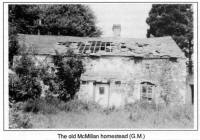 Land
purchase schemes, and in particular, the Northern Ireland
Land Act of 1925 gave many tenant farmers the opportunity to
buy their land. Those in Islandderry were no exception and
so without an annual source of income from rents the
Islandderry estate began to decline. Land
purchase schemes, and in particular, the Northern Ireland
Land Act of 1925 gave many tenant farmers the opportunity to
buy their land. Those in Islandderry were no exception and
so without an annual source of income from rents the
Islandderry estate began to decline.
It was sold by Timothy Waddell to Mr. and Mrs. Bertie
Wilson. At the beginning they lived in Alexander Waddal's
old house but when they began to renovate it, it was
discovered to be virtually beyond repair. A new family house
was built one hundred yards away and Islandderry House now
lies forlorn and derelict. The main staircase has collapsed,
ceilings are down and the basement impenetrable. Mr. Wilson
died last year and the estate is managed as a dairy farm,
under the name Island Dairy, by his remaining family.

Islandderry farm lay empty for many years supposedly due
to local superstition that bad luck went with the ownership
of the house.
Former owners include a Mr. McClelland from Banbridge and
a Major Beaument from Lurgan. It is now owned by Prima
Farms, a large company whose land agent is Mr. Draffin of
Dromore.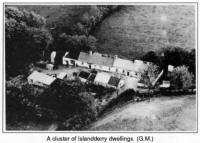
Although new houses abound Islandderry is no longer a
close-knit farming community. Only three of today's
residents were born in the townland. Many of the old
homesteads are derelict, but a twenty-five minute drive, by
way of the Hillsborough by-pass and the Ml, brings you into
Belfast. Islandderry has been transformed into perfect
commuter land.
According to parish Records for the period 1829-39,
several children born in Islandderry were baptised in the
Cathedral
as follows'.-
10th May 1829-Margaret of Samuel and Margaret
McCullough
21st May 1830-Anne of John Lamb and Susan Smyth
3rd April 1832-Marcia of Denis and Marcia Martin
15th July 1832-Michael of John and Susan Lamb
21st April 1833-Matthew of John and Jane Little
21st February 1834-David of William and Jane McKay
27th August 1837-Rosetta of James Morgan
20th September 1839-Elizabeth of William and Sarah Moore
By 1863 only Smyth and Moore were still living in the
townland whilst the Littles had moved to Gregorlough fifty
yards outside the Islandderry Boundary where their
descendants still live today.
September, 1992
Dear Martin,
Just to bring you up to date. Oats and barley are growing in
the fields. A new baby boy has arrived who is a Dempster
descendant. All is well in the townland of Islandderry!
R. McM.
RENT AT ISLANDDERRY 1st NOVEMBER, 1892
| Tenant |
Rent
Half |
Poor
Rate |
Cash |
| |
�.s.d.
|
�.s.d.
. |
�.s.d |
| John Arlow |
9.10.0
|
4s.4d.
|
9.5.8 |
| Mr. J. Thompson
|
10.0.0 |
4s.7d.
|
9.15.5 |
| Win. Dennison |
17.10.0 |
8s.0d.
|
17.2.0 |
| I. Smyth |
5.15.3
. |
2s.7d. |
5.12.8 |
| F. Beckett |
17.0.0
|
17s.10d. |
16.12.2 |
| J. Woods |
21.5.0
|
9s.9d.
|
20.15.3 |
| |
81.0.3
|
1.17.1
|
79.3.2 |
| Receipts for hay and grazing
|
January 1893 |
�204.0.0 |
|
| Rents |
January 1893 |
�237.19.9 |
|
Source-Waddell Letters D2129/1 - Proni.

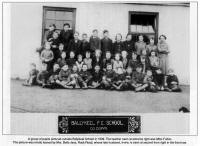
BALLYKEEL SCHOOL IN THE DAYS OF MASTER CRAWFORD
BY ANDREW DOLOUGHAN
"But past is all his fame. The very spot where many a
time he triumphed is forgot."
These lines by Oliver Goldsmith on "The Village Master"
have kept recurring in my mind since I decided to pen this
article on Ballykeel Public Elementary School, which once
stood almost opposite the Orange Hall on the Dromore
Ballynahinch Road.
To-day not a brick of the old building remains. For a
time after its closure, in 1939 I'm told, it was converted
into a bungalow. But eventually it was demolished, and Mrs.
Ena Graham now occupies the handsome new bungalow within its
precincts.
Around the same time the neighbouring school at Drumlough
was also closed and pupils from both centres were
accommodated in a new and much more commodious building on
the road leading from Drumlough Cross Roads to Ballykeel
Cross Roads.
Both the old schools had been blessed for a lifetime with
very gifted teachers - Mr. and Mrs. Sam Crawford at
Ballykeel and Mr. and Mrs. Charles Craig at Drumlough. Mr.
Craig continued to hold sway in the new school until around
1943 when Mr. Richard Beattie was appointed principal,
bringing gifts to equal, if not indeed surpass, anything
that had gone before. I speak with first-hand knowledge Mr.
Beattie, who was the master of Ballyvicknakelly School in my
closing years there, and who is still remembered with
affection and gratitude.
Mrs. Craig taught with Mr. Beattie at Drumlough until
about 1947 when he was joined by his wife Nancy.
MASTER FOR 28 YEARS
"Time and change are busy ever," and after 28 years as
the master at Drumlough Mr. Beattie decided to call it a day
in 1971, but his wife continued for the short time that
remained until the new school was also closed and the pupils
transferred to Anahilt and Dromara.
From here on I continue the story of Ballykeel School
with the help of one who had his education there and who has
very happy memories of his school days and of the Master and
Mrs. Crawford.
Needless to say, the present-day boys and girls have
little conception of what school days were like in the
1920's and 1930's, when this Province was getting back on
its feet following the Great War of 1914-18.
I was curious to know if my friend had ever used a slate
and slate pencil in his time at school. Of course he had,
and when the master ran out of slate pencils they went to
the "Golf' a quarry across the road - got a slate stone,
cracked it and used the pointed end as a pencil, "and you
could have written the very best with it," said Tommy.
That's not his name, but we'll call him that.
There were no free books or pencils in those days. You
had to buy your own and you didn't get fooling about and
destroying pages.
They were too precious, and the master would have "cut
the knuckles off you if there was any nonsense."
The slates were only used for lessons around the
blackboard, but at the desk it was a case of pens or pencils
and notebooks. Mr. and Mrs. Crawford were both well versed
in the art of calligraphy and the pupils had Vere Foster
headline copy books as a means of improving their writing.
I'm not sure if it's still there, but a house in Great
Victoria Street, Belfast, carried a plaque to the memory of
the inventor of this copy book.
COAL MONEY
In those days the classrooms were heated by means of coal
fires, and pupils had from time to time to take coal money
to help keep these fires stoked up.
Another thing which we take for granted nowadays is
electricity, television and radio. At the time of which we
are thinking most homes were lighted by means of oil lamps
or candles. The invention of the Tilley lamp, which gave
much better light, was a great boon.
The first TV programme which I can recall seeing was in
1952 at the time of Queen Elizabeth's accession to the
throne. Prior to that some of the well-to-do homes had
battery radios.
We got round to discussing the contents of school reading
books, and "Tommy" bemoaned the fact that the reading
supplied to the schools nowadays is not nearly so appealing
and does not place the same emphasis on morals as did the
stories and poems in the old school readers.
Our conversation turned to dress. "No school uniforms
then," said "Tommy" with a chuckle. "You were lucky if you
had something to wear that was handed down, even if the
trousers had a patch to keep your shirt tail from sticking
out. And for the boys it was all short trousers then and
stockings with turn-down tops. Some had trousers with
buttons at the knees. Most boys and girls had to keep good
the clothing they wore at school. Something less good was
used for romping about on Saturdays and at other times, and
for Sundays there was usually something better."
A PAIR OF CLOGS
"As to footwear, it was a case of bare feet or a pair of
'gutty' shoes in the good summer days and a pair of clogs,
which had wooden soles, in the bad winter days. Locally,
most of the clogs were made by Rabbie Watson of Gallows
Street."
But even then school had its light-hearted moments.
"Tommy" re-lived one of these as he recounted times when
Master Crawford might leave the room for a wee chat with a
local farmer who might be passing by with his horse and
cart.
This was the signal to start up a bit of dance-band music
using the partition wall between the two class rooms to drum
on. Never once did Mrs. Crawford try to stop this. Rather,
"Tommy" thought she enjoyed the whistling and singing, "for
she was a real musician and a very nice woman." But when the
master returned a "court martial" began and the musicians
usually got two or three slaps apiece.
Like most schools, Ballykeel had a poem about the master,
and it ran something like this:
Sammy Crawford's a nice wee
man.
He tries to teach us all he can.
To read and write and `rithmetic,
But he's the boy can use the
stick.
McADAM'S CROSS ROADS
Leaving Ballykeel School we took up our stand in heart
and mind with the boys who assembled at McAdam's Cross Roads
mostly in the long summer evenings. "One would have thought
there was something wrong if there weren't at least a dozen
or more there," he said.
The crack was always good, and one had a choice of a game of
skittles, marbles, quoits or football - the latter in the
"Sticky Park," a field off the Ballykeel Road. Occasionally
there might be a bit of a concert, the music being supplied
on violin, mandoline, flute or mouth organ.
We went over the names of some who frequented the Cross
Road and were shocked to find that few of them are alive
to-day. Names that readily came to his mind were - John
Gamble, Sandy, Willie and Stanley Young, Billy Porter, John,
Sandy and Sam Gourley, Jim Chambers, Billy Shannon, Rabbie
Armstrong, Jimmy, Tommy and Willie Hamilton, John Hunter,
Bob, Hugh and Tommy McClune, John Doloughan, William,
Geordie and Sammy Wilkinson, Sam Allen, Joe Gamble, Jimmy
and Willie Wallace, Willie Coulter, John Wilson, Herbie
Scott, Sandy Steele, Jimmy Scott, Billy and Jim McNeill,
Fred Jess, Willie Jess, Sammy Jess, Jimmy Tinsley, David
Black, Walter and Jim Black, Sam and David Gibson.
Vehicular traffic in the years of which we are speaking
was very light. Cars most frequently seen on the
Ballynahinch Road were those owned by the late Joseph
Lindsay (The Leader), Hawthorne Bennett, Robert J. Poots,
Jack Bailey, Hugh Corbett and the renowned Harry Ferguson,
who had been a pupil of Ballykeel School.
The thought of the few cars in the countryside then
prompted "Tommy" to remark "It's a nightmare on the roads
now, and until the powers that be cut down the speeds that
cars are able to do it will be no better."
Another thing he doesn't agree with is the driving test.
He feels that passing the test gives some people the
impression that they have nothing more to learn about
driving - and that's all wrong, he says.
We went on to recall one of the motor bikes in the
district in those days. It was owned by the Rev. William
Bill, minister of Drumlough Presbyterian Church, who kept a
few stones in the side car to steady it on the road.
Mr. Bill's successor was the Rev. William Copes - "a man
in whom the congregation placed great confidence." As an
entertainer he is remembered for his ability to recite such
delightful pieces as "I'm living in Drumlister in clabber to
the knee" (by the Rev. W. F. Marshall) and "The man with one
hair".
The precentor of Drumlough Church Choir was John Gibson,
a handloom weaver who also played the violin. He lived
between McAdam's Cross Roads and Ballykeel Hill, the sloping
banks of which are a reminder that it was much steeper a
lifetime ago.
At the roadside by John's home was a blacksmith's forge,
run by John Magowan, whose brother Nelson is well known in
the district. Another brother, the late Sam, was the Member
of Parliament for Iveagh for some years. Another smithy to
operate at the forge was Ernie Hanna.
Towards the foot of the hill Mark Hamilton had charge of
McAdam's Cross Roads Post Office. He also sold sweets,
groceries and paraffin oil. The Post Office is now located
at The Pole on the Leapoughs Road, and the postmistress is
Mrs. Annie Sudlow.
"GROVEY'S LODGE"
Near Ballyvicknakelly School there met a group known as "Grovey's
Lodge." This consisted of a number of young men from the
district who congregated in the evenings in the home of Hugh
Watson, known in the area as "Grovey" because he resided at
Watson's Grove.
The "crack" there was always good. If any of the group
got a bit of news about any of the others, their latest
romances and so forth, the idea was to arrive first and have
"Grovey" primed so that he could let the cat out of the bag
when the "lodge" was in full flight.
I close with a warm word of thanks to "Tommy" for his
time and interest. I'm sorry he chose to remain anonymous,
but that wish I must respect.

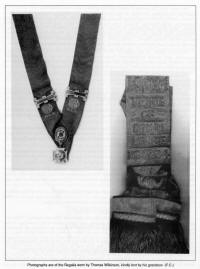 |
 |
|
"THE BUFFS"
THE ROYAL ANTEDILUVIAN ORDER OF BUFFALOES
by
WILL PATTERSON |
The RAOB Buffs Lodge No 4294 was formed in Dromore in the
early 1920's and met in the premises of John Murphy in
Bridge Street. After meeting in a few other locations they
moved to premises beside Alma Lodge in Castle Street and
around 1935 eventually moved to the Crown Hotel in Meeting
Street where they had a Buffs Hall in the Crown's yard. The
RAOB order was a benevolent order and like the Masonic order
it helped educate the children of deceased members. The
order is open to members of all religions.
The members have to pass degrees at risings, which are
conducted by the Grand Lodge in Ireland. Members are
presented with degrees and Jewels suitably inscribed. One of
the oldest medals the present writer has seen was a Knight
of Merit jewel which was presented to Thomas Wilkinson, Boot
and Shoe repairer formerly of Bridge Street, Dromore. It is
a 9ct. gold medal, with the date May 1923. He also had the
worthy Primo jewel and also a sash with the RAOB 4294
presented also.
The members of the Lodge had an annual outing each year
and went around the Co. Down coast. They held Christmas
parties for children each year.
One of the first secretaries of the Dromore 4294 Lodge
was Arthur Beattie, Rampart Street, who was manager of
Josiah Ward's public house in the Square. Another secretary
was W. J. Thompson of Iveagh Terrace who had been a colour
sergeant in the army. Ernest V. Copling who was Chauffeur to
the Graham family, Clarence McMurray of Meeting Street and
John Aherne of Maypole Park filled the role of secretary
over the years until with the passing of time the lodge was
disbanded in the 1980's as most of the members had passed
away.
This ended the Buffs in Dromore after a period of over 60
years and those who had sought to keep the lodge going
included B. Bingham, W. D. Kelly, Ed. Poots, J. Aherne, Ed.
Boal, C. McMurray, V. McMurray, W. J. Wilson, G. Lilley, K
Lindsay, W. H. Gamble and Robert Gailey.

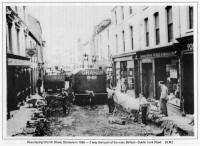
DROMORE'S PIPE DREAM
BY HUGH R. MOORE
It was thought for many long centuries that Troy (of the
Wooden Horse) was just a name used by the Greek poet Homer
in his famous poem about a fictious war. Then when ancient
Troy was discovered and excavated in 1870, it was realised
that the poem was not fiction but an account of a real place
and a real war and it was also discovered but there had been
possibly ten Troys built and destroyed in battles with their
enemies. Why, you ask, begin an article on a sewerage system
by a reference to ancient Troy? - for this reason; when we
visited this ancient site some years ago we were surprised
to see that it had had a sewerage system; partly open
drains, which had to be helped to perform their function,
but also there were crude pipes excavated in the ruin,
probably dating back to the 13th century before Christ.
Sewerage systems are as old as intelligent man - wherever
people have come together they have been part of organised
life. It is easy, using a little imagination, to see how the
necessity arose. Take Dromore (or any other town, but we are
interested in Dromore) - many years ago the `road', then not
much more than a track, known later as the Old Coach Road
(running from Carrickfergus to Dublin), passed through
Drummor, it became Dromore. The river could be forded there
and so it became a stopping place. First a cottage would be
built, then another, then one or two crude dwellings until
gradually a small settlement appeared. As it grew provision
had to be made for the traveller and the inhabitants. It
became more complicated with each new dwelling. The open
field, the dry toilet, the open drain into the river and
later, much later, a crude septic tank. As the town grew
there was a tangle of pipes and drains, all heading towards
the river and every new dwelling added to the problem. I
remember seeing one of the open drains which had been
covered and was revealed during excavation. In our
imagination we can see the little village developing around
the muddy square.
During the early years of the century small schemes were
carried out from time to time, trying to improve what seemed
to be unimprovable. Each householder and merchant was a law
unto himself and parts of `The System' were always giving
trouble. With the passing years more voices were saying that
something would have to be done. At this time Commissioners
were responsible for the affairs of the town and knew about
the problem. When the Urban Council was formed in 1922 they
inherited this difficult question and the matter was raised
and discussed from time to time but, what with a war just
over and with various money problems, it was postponed, but
never allowed to be forgotten. Money was gathered from
various sources. For instance, in May 1940 it was reported
at a Council meeting that a sum of �1,000 was available to
the Council and it was decided, on the proposal of Dr. J. C.
Wilson, that it be invested in War Loan until the Council
was in a position to take the matter up. The years rolled
by, and as soon as the second World War was over, while
there were many pressing needs, the Council decided to move
as quickly as possible for the system that did exist was
fast failing. Ultimately, after due consultation with the
appropriate government departments, in particular with the
Department of Health and Local Government, on the 20th of
January 1948 the Clerk informed the Council that the plans
for the proposed sewerage system had been sent to the
Government department responsible. Suitable loans had been
established and tenders for the work were sought.
On the 11th August of that year the Council received five
tenders for the construction of the system. The lowest was
received from Messrs John Graham and Sons, as the firm was
then known. The tender price was �77,947 eight shillings and
five pence - a large sum in those days. This tender was
accepted, it was pointed out that the firm undertook to
carry out the work in 30 months. The Council was also
informed that the Government would meet 66�/�
per cent of the cost. Most of the rest of the cost it was
thought would have to be raised through the rates.
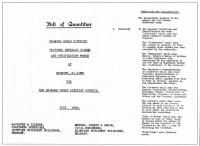
It was known at the time that it would cost much more, it
did! - over �50 thousand more and this did not include all
the other work that was necessitated because of the scheme.
When it was known that the green light was on for the
scheme, the people of the town were delighted, for it would
mean the end of dry toilets and weekly cleansing by the
scavenger brigade of the Council. However, as was
anticipated, there were going to be difficulties, as happily
they were few. The very favourable weather during the
initial months meant that the river was low and this
facilitated the installation of the pipes in the river bed
and the concrete casing over them.
The flat concrete surface along the river bank proved to
be an attraction to the children, who ran along it were in
danger of slipping off it, which could have been fatal if
the river were in spate. This was raised by Mr. Francis
Russell and the Council discussed it. It would seem there
was no action that could be taken. Also with so much
excavation there were many tracks in the roads. This
resulted in a number of claims for broken car springs.
When the pipes were laid and the system operating, the
various householders had to make the connection. Some were
initially unwilling to do so and for some time the two, or
perhaps several, systems were in operation. This, of course,
was a small matter compared to the task of providing toilets
for 70% of the houses which had only the dry toilets. This
took time, but it was achieved. For some years the Council
continued to be responsible for some rural cottages. During
the digging of the trenches not only did the contractor come
up against stubborn rock but, in some ways more difficult,
there were the pipes of many centuries impossible to tell
where some of them came from or where they went to. I
remember the trench in the Square as being very deep.
All this helps us to understand the difficulties of the
scheme. The disposal works were situated at the town end of
Holm Terrace on ground purchased for this purpose; the main
pipe running along the path on the right-hand side of the
river going towards Holm Terrace. On a number of occasions
cattle on the south bank of the Lagan came across when the
river was low and did some damage to the filter system in
the disposal plant.
After the system was fully established it was stated that
it was at full capacity and for this reason it would be
unlikely that the town would be able to develop further.
However, when some of the first of the new estates were
anticipated, it was found that the capacity could be
increased by pumping stations and other means. The High
School was the first to benefit by this and, as we all know
and rejoice in, there have been some very large and valuable
developments since it was said that `Dromore will not be
able to develop because .....'
I remember an interesting experience when the work was
almost finished. One of the engineers whom I had met offered
to take the late S. J. Duffy, who at that time owned the
bakery shop in Church Street, and myself to see the disposal
works at Holm Terrace and to explain the workings to us. The
two things I remember from this experience were that,
according to the engineer, we could drink the water that
flowed from the system - neither of us volunteered!!
The other thing I remember was when Mrs. Duffy was giving
us a cup of tea afterwards, the engineer explained that to
put the tea in first and then add the milk was a colloid and
to put in the milk first and then to put in the tea was a
solution. Chemically, he seemed to indicate, they were two
different drinks.
On second thoughts - was it the other way round? the tea
first - a solution, and the milk in first a colloid. Well,
it is one or the other. Perhaps I am confused - like the
original tangle of pipes under Dromore!!!!!
Thanks to Messrs. I. Bill and D. Leeman of
Graham's Dromore for their help.
 |